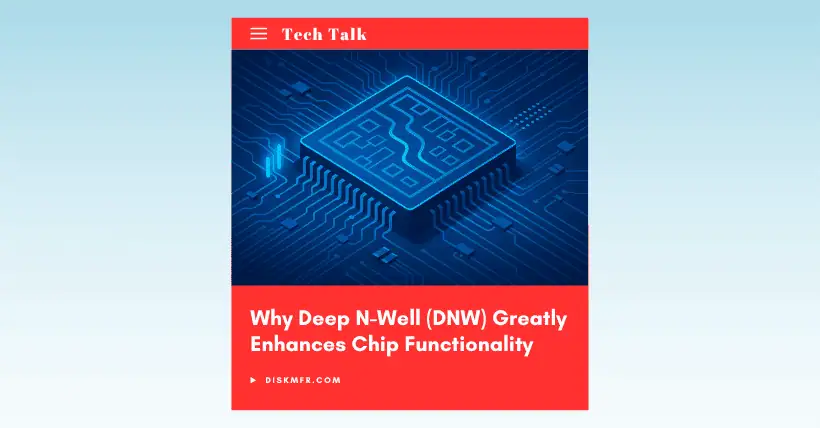In semiconductor processes, DNW (Deep N-Well) ion implantation is a key technology mainly used to create deep N-type well regions in P-type substrates. This technology is particularly important in CMOS integrated circuits, BCD (Bipolar-CMOS-DMOS) processes, and high-voltage device manufacturing. The following outlines the core functions and technical details of DNW ion implantation:
I. Core Functions of DNW
- Device Isolation and Circuit Partitioning
Application scenario: Isolating circuits with different voltage domains in mixed-signal ICs (e.g., SoCs).
Principle:
By injecting a high dose of phosphorus (P) or arsenic (As) ions into a P-type substrate, a deep N-well is formed. This well acts as a “container” to isolate high-voltage or noise-sensitive circuits (e.g., RF front-ends, power management modules) from low-voltage digital circuits, preventing interference.
Advantages:
- Eliminates latch-up risk, improving circuit stability.
- Supports multi-voltage domain designs (e.g., coexistence of 1.8V logic and 5V/12V analog circuits).
- Constructing Special Device Structures
High-voltage NMOS/PMOS:
DNW can serve as the substrate for high-voltage PMOS, where the breakdown voltage (e.g., 60V/100V devices) is controlled by adjusting DNW doping concentration.
BCD Process:
In power ICs, DNW is used to isolate high-voltage DMOS from low-voltage CMOS, enabling monolithic integration.
- Noise Performance Improvement
Analog Circuit Protection:
DNW can act as a shielding layer to reduce substrate noise interference in high-precision analog circuits (e.g., ADCs, PLLs).
RF Applications:
In RF CMOS processes, DNW reduces parasitic capacitance and improves high-frequency performance (e.g., fT/fmax).
II. Technical Details of DNW Ion Implantation
- Process Parameters
Implanted ions: Typically phosphorus (P) or arsenic (As), with energy ranges from 1–5 MeV (forming wells 2–5μm deep).
Dosage: Typical values are 10¹²–10¹³ cm⁻², balancing breakdown voltage and parasitic capacitance.
Energy layering:
Multi-energy implantation (e.g., 3MeV + 2MeV + 1MeV) is used to create a graded doping profile and optimize electric field distribution.
- Key Challenges
Impurity diffusion control:
High-temperature processes (e.g., activation annealing) may cause DNW edge diffusion, requiring thermal budget optimization.
Secondary defects:
High-energy implantation can cause lattice damage, which must be repaired through high-temperature annealing (e.g., above 1000°C).
III. Typical Application Cases
- Mixed-Signal IC Design
Scenario: Integrating 1.8V digital circuits with 5V analog circuits on the same chip.
Solution:
Digital circuits are placed in P-wells/N-wells in the P-substrate.
Analog circuits are placed in DNW, with DNW connected to the highest supply voltage (e.g., 5V) to isolate noise.
- Power Device Integration
BCD Process:
DNW serves as the drain extension region for high-voltage DMOS, capable of withstanding high voltages (e.g., 40V).
The low-voltage CMOS section remains in conventional P-well/N-well regions, enabling monolithic integration of power and logic.
- Automotive Electronic ICs
Requirement: Tolerate load dump voltages exceeding 40V.
Design:
DNW combined with RESURF (Reduced Surface Field) technology increases breakdown voltage to over 60V.
IV. Technological Development Trends
High-energy implantation optimization:
Using MeV-level ion implanters improves depth uniformity and reduces channeling effects.
Low-dosage DNW:
In FD-SOI processes, low-dosage DNW is used to regulate back-gate effects and optimize device performance.
V. Conclusion
DNW ion implantation is a core technology for achieving circuit isolation, high-voltage device integration, and noise control. By precisely controlling implantation energy, dosage, and distribution, engineers can integrate circuits of different voltage domains and functions on a single chip while ensuring performance and reliability. With growing demands for high-voltage and high-integration ICs in automotive electronics, 5G communications, and other fields, DNW technology will continue to evolve and deeply integrate with new materials and structures.

Disclaimer:
- This channel does not make any representations or warranties regarding the availability, accuracy, timeliness, effectiveness, or completeness of any information posted. It hereby disclaims any liability or consequences arising from the use of the information.
- This channel is non-commercial and non-profit. The re-posted content does not signify endorsement of its views or responsibility for its authenticity. It does not intend to constitute any other guidance. This channel is not liable for any inaccuracies or errors in the re-posted or published information, directly or indirectly.
- Some data, materials, text, images, etc., used in this channel are sourced from the internet, and all reposts are duly credited to their sources. If you discover any work that infringes on your intellectual property rights or personal legal interests, please contact us, and we will promptly modify or remove it.








